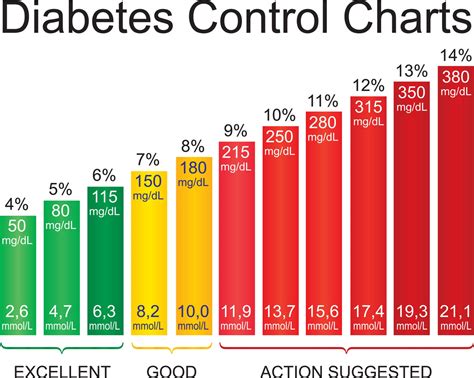Intro
Understanding the importance of maintaining healthy blood glucose levels is crucial for overall well-being, particularly for individuals with diabetes. The glucose range chart is a valuable tool that helps track and manage blood sugar levels, ensuring they remain within a target range. This range is essential for preventing complications associated with diabetes, such as heart disease, kidney damage, and nerve damage. By monitoring blood glucose levels, individuals can make informed decisions about their diet, exercise, and medication, ultimately improving their quality of life.
The glucose range chart is especially useful for individuals with diabetes, as it provides a clear and concise way to track their blood sugar levels throughout the day. By monitoring these levels, individuals can identify patterns and trends, making it easier to adjust their treatment plan as needed. Healthcare providers also rely on glucose range charts to assess the effectiveness of a patient's treatment plan and make adjustments to medication, diet, or exercise recommendations. Moreover, understanding the glucose range chart helps individuals recognize the signs and symptoms of hyperglycemia (high blood sugar) and hypoglycemia (low blood sugar), enabling them to take prompt action to prevent serious complications.
The management of blood glucose levels is a complex process that involves a combination of lifestyle modifications, medication, and regular monitoring. The glucose range chart plays a critical role in this process, serving as a visual aid that helps individuals understand their blood sugar levels and make informed decisions about their care. By using the glucose range chart in conjunction with other management strategies, individuals can effectively manage their diabetes, reducing the risk of complications and improving their overall health and well-being.
Understanding the Glucose Range Chart

The glucose range chart is a graphical representation of the target blood glucose levels for individuals with diabetes. The chart typically includes the following ranges:
- Fasting blood glucose: 70-130 mg/dL
- Before meals: 70-130 mg/dL
- After meals: Less than 180 mg/dL
- Bedtime: 100-140 mg/dL These ranges may vary depending on the individual's specific needs, age, and health status. Healthcare providers work with patients to determine their target glucose range and develop a personalized treatment plan.
Key Components of the Glucose Range Chart
The glucose range chart includes several key components, including: - Target glucose range: The ideal range for blood glucose levels, which may vary depending on the individual and their specific needs. - Blood glucose monitoring: Regular monitoring of blood glucose levels to track progress and make adjustments to the treatment plan as needed. - Medication management: The use of medications, such as insulin or oral hypoglycemic agents, to help regulate blood glucose levels. - Lifestyle modifications: Changes to diet, exercise, and other lifestyle habits to help manage blood glucose levels and improve overall health.Benefits of Using a Glucose Range Chart

Using a glucose range chart offers several benefits, including:
- Improved blood glucose control: By tracking blood glucose levels and making adjustments to the treatment plan, individuals can achieve better control over their blood sugar levels.
- Enhanced quality of life: Effective management of blood glucose levels can reduce the risk of complications and improve overall health and well-being.
- Increased patient engagement: The glucose range chart empowers individuals to take an active role in their care, making informed decisions about their diet, exercise, and medication.
- Better communication with healthcare providers: The chart provides a clear and concise way to communicate with healthcare providers, ensuring that individuals receive the best possible care.
Implementing a Glucose Range Chart in Daily Life
Implementing a glucose range chart in daily life involves several steps, including: 1. Monitoring blood glucose levels regularly 2. Recording results in a logbook or using a mobile app 3. Adjusting the treatment plan as needed 4. Communicating with healthcare providers regularly 5. Making lifestyle modifications, such as changes to diet and exercise, to help manage blood glucose levelsCommon Challenges and Solutions

Individuals using a glucose range chart may encounter several challenges, including:
- Difficulty staying within the target glucose range
- Managing blood glucose levels during special occasions or holidays
- Dealing with hypoglycemia or hyperglycemia Solutions to these challenges include:
- Working closely with healthcare providers to adjust the treatment plan
- Developing a meal plan that takes into account carbohydrate intake and glycemic index
- Carrying a glucose meter and testing strips at all times
- Keeping a logbook or using a mobile app to track blood glucose levels and identify patterns
Tips for Effective Glucose Range Chart Management
Effective management of the glucose range chart involves several tips, including: - Testing blood glucose levels at the same time every day - Recording results in a logbook or using a mobile app - Analyzing trends and patterns to make informed decisions - Communicating regularly with healthcare providers - Making lifestyle modifications, such as changes to diet and exercise, to help manage blood glucose levelsReal-Life Examples and Case Studies

Several real-life examples and case studies demonstrate the effectiveness of using a glucose range chart, including:
- A study published in the Journal of Diabetes Care, which found that individuals who used a glucose range chart had better blood glucose control and reduced risk of complications
- A case study of an individual with type 2 diabetes, who used a glucose range chart to adjust their treatment plan and achieve significant improvements in blood glucose control
- A review of mobile apps for glucose range chart management, which found that these tools can be effective in improving blood glucose control and enhancing patient engagement
Future Directions and Emerging Trends
The future of glucose range chart management is likely to involve emerging trends, such as: - The use of artificial intelligence and machine learning to analyze blood glucose data and provide personalized recommendations - The development of wearable devices and mobile apps for glucose range chart management - The integration of glucose range chart management with other health technologies, such as electronic health records and telehealth platformsConclusion and Final Thoughts

In conclusion, the glucose range chart is a valuable tool for managing blood glucose levels and improving overall health and well-being. By understanding the key components of the chart, implementing it in daily life, and overcoming common challenges, individuals can achieve better blood glucose control and reduce the risk of complications. As the field of glucose range chart management continues to evolve, emerging trends and technologies are likely to play an increasingly important role in improving patient outcomes and enhancing the quality of care.
Final Recommendations
Final recommendations for individuals using a glucose range chart include: - Working closely with healthcare providers to develop a personalized treatment plan - Monitoring blood glucose levels regularly and recording results in a logbook or using a mobile app - Making lifestyle modifications, such as changes to diet and exercise, to help manage blood glucose levels - Staying up-to-date with emerging trends and technologies in glucose range chart managementWhat is the target glucose range for individuals with diabetes?
+The target glucose range for individuals with diabetes is typically between 70-130 mg/dL for fasting blood glucose and before meals, and less than 180 mg/dL after meals.
How often should I monitor my blood glucose levels?
+The frequency of blood glucose monitoring depends on individual needs and health status, but most healthcare providers recommend monitoring at least 3-4 times per day.
What are the benefits of using a glucose range chart?
+The benefits of using a glucose range chart include improved blood glucose control, enhanced quality of life, increased patient engagement, and better communication with healthcare providers.
We hope this article has provided you with a comprehensive understanding of the glucose range chart and its importance in managing blood glucose levels. If you have any further questions or would like to share your experiences with using a glucose range chart, please don't hesitate to comment below. Additionally, if you found this article informative and helpful, please consider sharing it with others who may benefit from this information.
